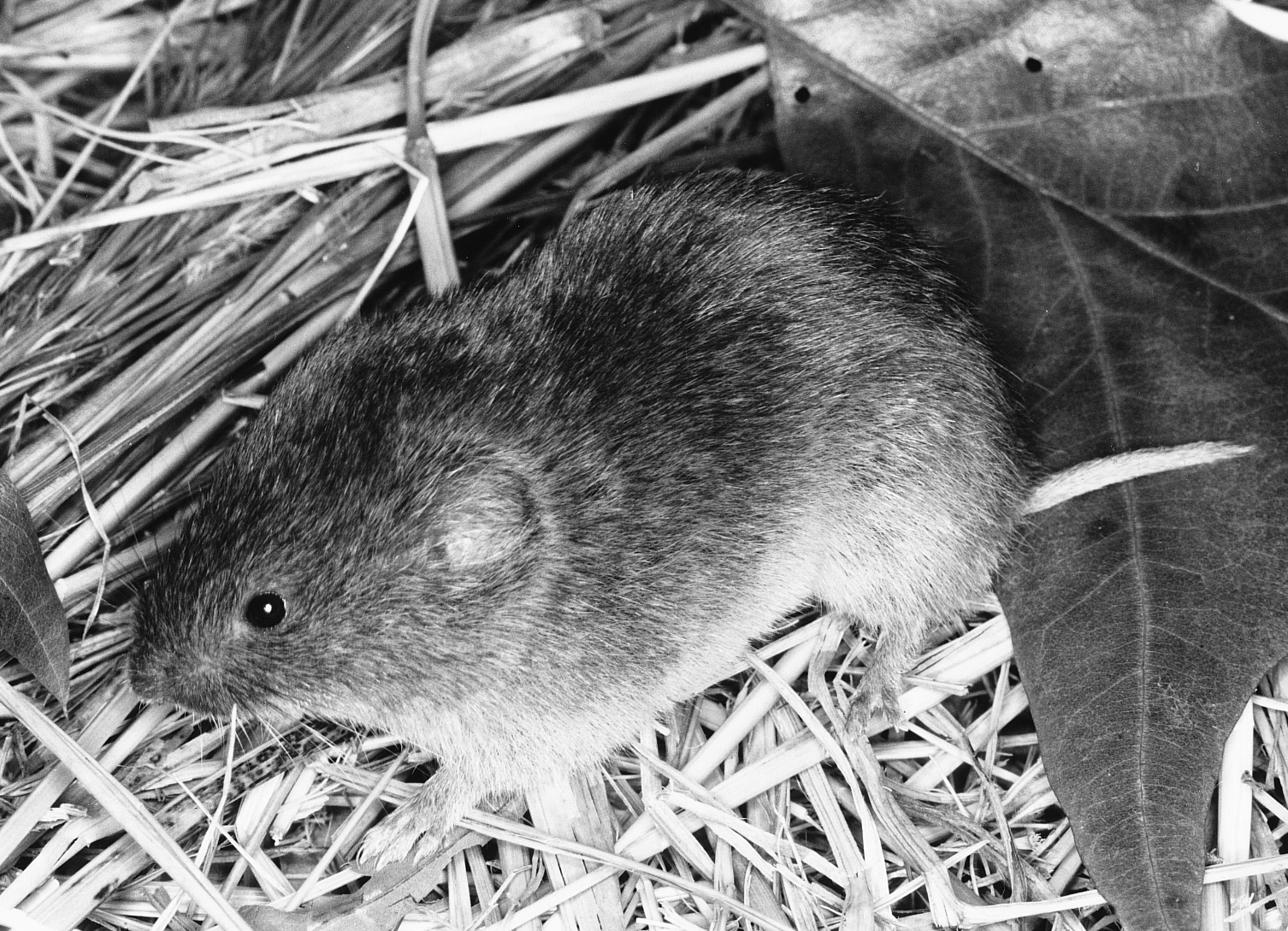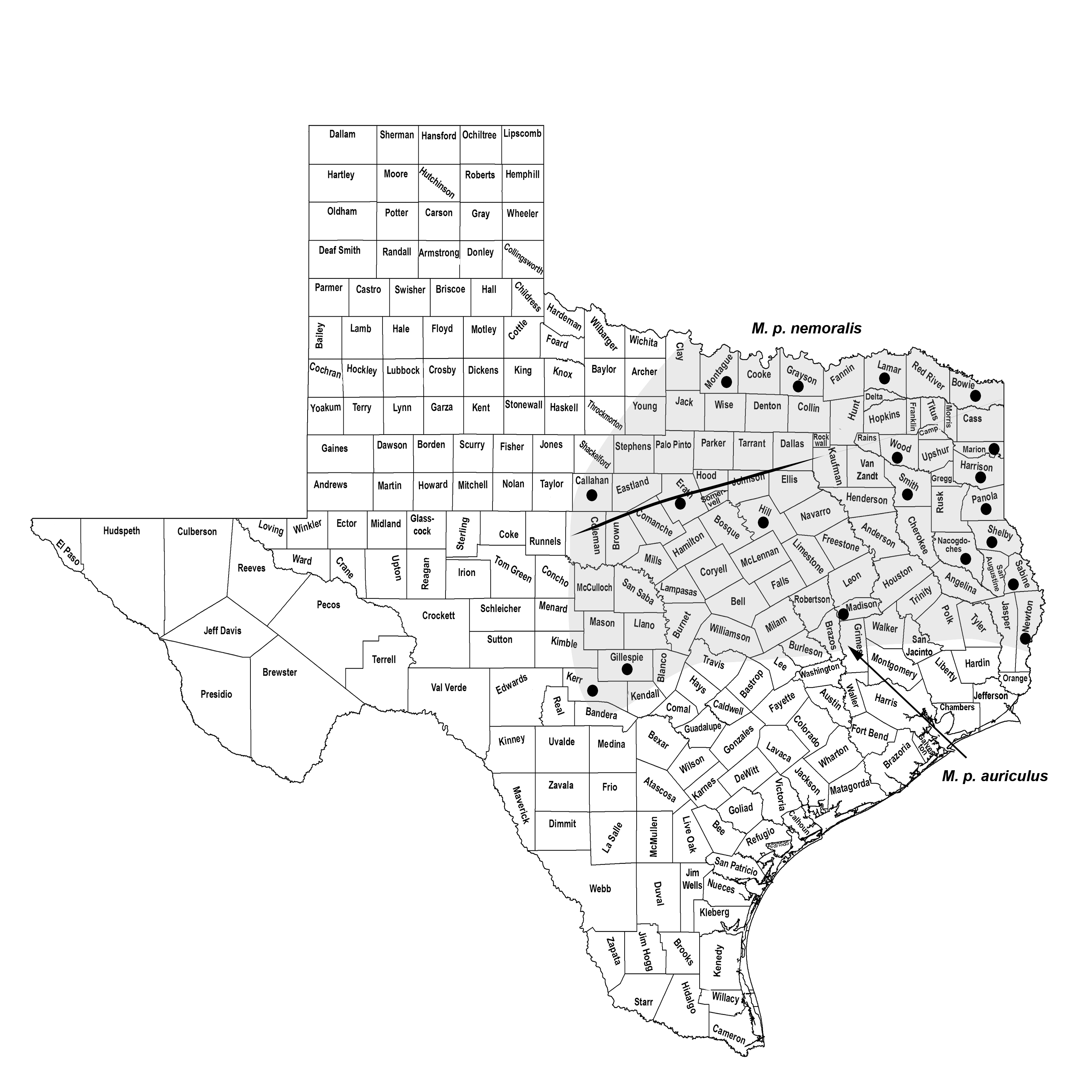WOODLAND VOLE
Microtus pinetorum (Le Conte 1830)
Order Rodentia : Family Cricetidae
DESCRIPTION. A small vole with short, dense, glossy fur and short tail; five tubercles on sole of hind foot; two pairs of mammary glands, inguinal in position; upperparts dull chestnut tinged with black; underparts tinged with cinnamon; tail slightly darker above than below. Juveniles plumbeous gray, tinged with chestnut. Dental formula: I 1/1, C 0/0, Pm 0/0, M 3/3 × 2 = 16. Averages for external measurements: total length, 135 mm; tail, 25 mm; hind foot, 18 mm. Weight, 25–45 g.

DISTRIBUTION. Found in eastern and central parts of state west to Callahan, Kerr, and Gillespie counties, but nowhere does it appear to be common within its range in Texas.

SUBSPECIES. Microtus p. auricularis in the southern part of the range in Texas and M. p. nemoralis to the north.
HABITS. These voles occur largely in woodland areas where ground cover in the form of leaf litter and lodged grasses offers suitable protection. They are rarely, if ever, found westward in the zone of sparse rainfall. This fact seems to correlate well with their preference for burrowing just under the surface of the ground, much after the fashion of moles. Although they sometimes use surface runways in grassy areas, they are more inclined to spend their time in underground galleries that they dig for themselves or usurp from moles, short-tailed shrews, or other small mammals. Their burrows are about 4 cm in diameter and seldom more than 7–10 cm beneath the surface of the ground. The normal home range of individuals appears to be about one-tenth of a hectare.
The nest is globular in shape, constructed mainly of dead grasses, leaves, and other
vegetation, and usually placed in a special chamber in the ground. Occasionally, it
is located under a partly buried log or among the roots of a stump. Two or more passages
usually lead from it to the surface, thereby providing avenues of escape.
The food of the woodland vole is largely roots and tubers. Specific items include
peanuts, tuberous roots of violets and other herbs, berries of red haw, bark from
the roots of several kinds of trees and shrubs, roots of several grasses, acorns,
and nuts of various kinds. Due to their subterranean habits, these voles rarely sit
up to eat; instead, the food is held pressed against the floor of the burrow.
The breeding season extends at least from February to October and may continue through the winter. During the breeding period, an adult female may give birth to as many as four litters of two to four young. At birth, the young ones are blind and naked and weigh slightly >2 g. In about 1 week, they are well furred; the eyes open in 9–12 days; and they are weaned when about 17 days old. They begin to acquire adult pelage at about 4 weeks of age. The gestation period is reported as 24 days.
In orchards, these mice may become so abundant as to cause considerable damage by girdling roots and killing trees, but otherwise they are not of much economic importance. Predators include barn owls, hawks, rat snakes, gray foxes, opossums, mink, and weasels.
POPULATION STATUS. Uncommon. The woodland vole has a highly scattered and localized distribution in the eastern and central parts of the state. Nowhere does it appear to be common, and continued degradation of grassland habitats could greatly impair its status in Texas. There are no recent records from the Hill Country or other places where it was once taken, and grasslands have been converted to shrubland habitat.
CONSERVATION STATUS. The IUCN lists the woodland vole as a species of least concern, and it does not appear on the federal or state lists of concerned species. The woodland vole bears careful monitoring in the future.
From The Mammals of Texas, Seventh Edition by David J. Schmidly and Robert D. Bradley, copyright © 1994, 2004, 2016. Courtesy of the University of Texas Press.
Natural Science Research Laboratory
-
Address
Museum of Texas Tech University, 3301 4th street, Lubbock, TX 79409 -
Phone
806.742.2486 -
Email
nsrl.museum@ttu.edu

